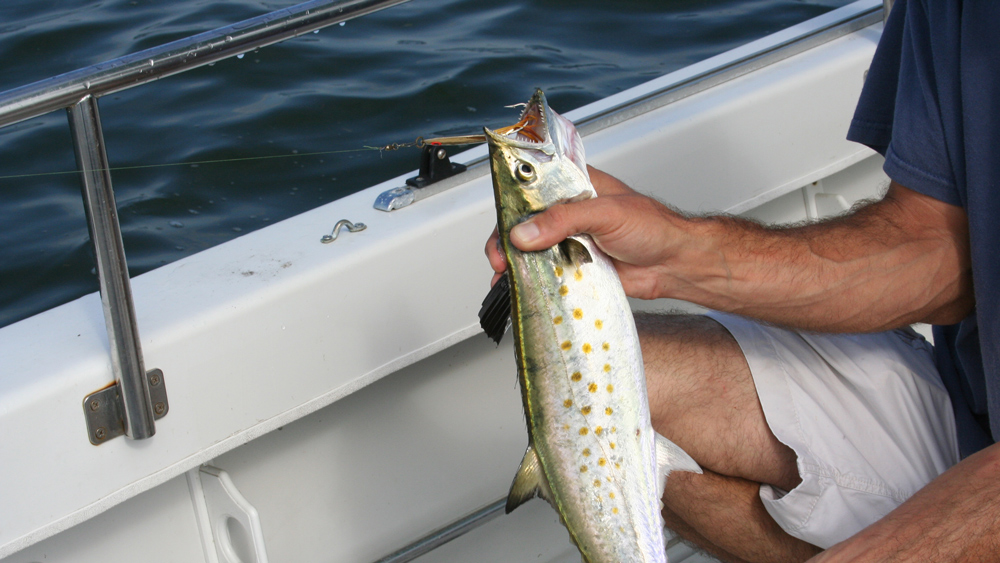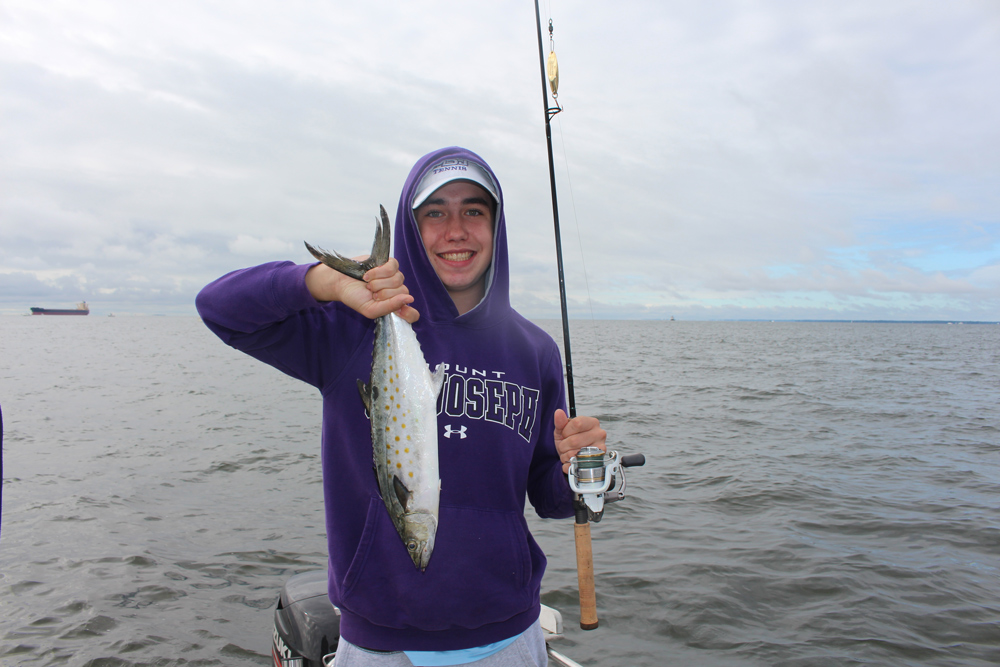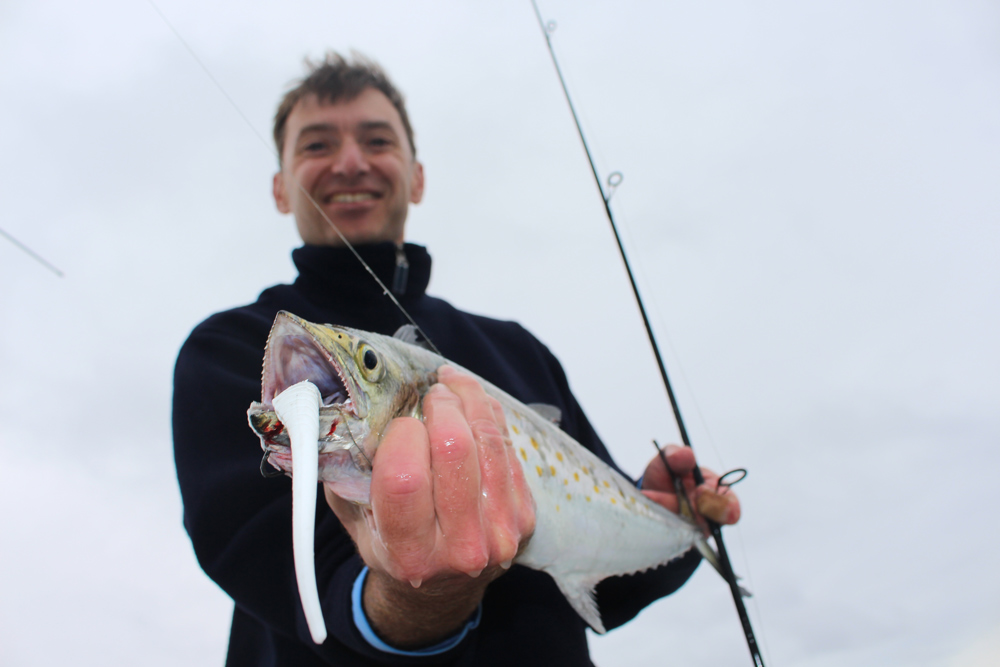Spanish mackerel are like mini-pelagics of Chesapeake Bay fishing. They’re lightning-fast speedsters with a lot of pullage-per-pound, and although they’re only in our neck of the woods for the summer months, provide a great diversion from the usual species we pursue. Ready to charge out and go on a mack attack? Then it’s time to…

Spanish Mackerel Fishing Gear
Trollers will want to use medium to heavy tackle even though these fish aren’t huge (most range between three and seven pounds) because they’ll also want to employ diving planers. A Sea Striker or Drone number-one or number-two planer should be clipped via swivel onto the main line, then attached via a ball-bearing swivel to 15 to 20 feet of 30-pound leader. The ball-bearing swivel is important, because at the far and of this leader you’ll attach a spoon. Neglect the swivel, and there’s some heavy-duty line twist in your future.
Two and three inch gold and silver Clark, Drone, and Tony spoons can’t be beat. Spanish often prefer gold, and most anglers will run three or four golds, a silver or two, and an oddball or two (with chartreuse, blue, or red prismatic tape) in their spreads. The bulk of the spread gets placed down deep with the planers, while a line or maybe two gets run up top with just a couple ounces of lead. Nine times out of 10 the planer lines catch the lion’s share of the fish, but on occasion they just seem to want to hit up top near the surface.
Trolling for Mackerel
Trolling for Spanish is not a mixed-species event. You need to dedicate yourself to the Spanish, and accept the fact that you won’t be catching stripers at the same time. Trolling speed gets bumped up well above rockfish territory, into the seven mph range. You’ll still pick up some blues at this speed, but the general rule is that if you’re catching lots of bluefish it means you’re going a hair too slow – pick up the pace a bit.
The area(s) you troll will also need to be varied a bit. Of course, the best way to stay on top of where the Spanish are at any given time is to check the FishTalk fishing reports. Aside from that, you should keep a sharp eye out for birds and/or breaking fish. Mackerel will often be mixed in among the stripers and blues chasing bait up top. If you see bunker getting busted, however, remember that the mackerel are likely elsewhere. They tend to chew on silversides, anchovies, and similar small bait – which is why the small spoons are so effective.
When you do see fish up top, keep an eye out for gray-hounding. If you see any fish doing it, head for that spot. You’ll virtually never see stripers nor blues gray-hounding across the surface but mackerel do it regularly.

Look for areas of cleaner water, too. Spanish macks do like to feed in water that’s on the cleaner side, and if there’s a pocket of water with higher visibility than surrounding areas, there’s a good chance that’s where you’ll find ‘em. Because of this as a general rule of thumb you’ll often do better on Spanish on the Eastern side of the Bay in Middle-Bay areas, though once you get to Point Lookout and points farther south, the difference is far less dramatic. At the mouth of the Bay and along the coast, finding a color change and trolling the cleaner side can be productive.
Jigging for Spanish Mackerel
Many of us eschew the trolling gear in favor of light tackle virtually every time we fish. When it comes to Spanish mackerel, however, your chances of catching fish are three to five times better if you troll. Yes, I know (because I feel the same way!) that many of us will still want go after the Spanish by casting into schools of breaking fish. That’s great, just be realistic about the likely results. That said, you will enjoy a much better chance of catching stripers and blues by “accident” than you would when trolling.
Though you will pick up a Spanish now and again on a plus, jig, or live bait, small gold spoons are still the best offering. They can be tough to cast, but rigging a one-ounce torpedo weight a few feet above the spoon will give you much better range. The most important thing is to reel quickly – very quickly. In fact, cranking a spinning reel at the very fastest pace you can physically maintain is not at all too fast for these fish. Note: it’s virtually impossible to get a lure much past six mph when cranking a spinning reel. Measure out a distance, time yourself with a stopwatch, and do the math. The best I could do with a 6500SS was 6.2 mph and I couldn’t maintain that for long.

Sweet and Simple Spanish Mackerel Recipe
Spanish mackerel have oily meat, and much like bluefish, they’re excellent fresh but not nearly as appealing after they’ve been frozen. So it’s best to plan to eat them a day or two after catching ‘em. Also be sure to ice them down thoroughly and immediately.
If you’re feeling adventurous and you enjoy sushi, try making your own home-brewed Saba:
- Fillet the fish, then cover the fillets completely in Kosher salt. Allow them to sit for about an hour.
- Rinse the fillets gently in a bowl of water (not under running water) and pat them dry.
- Place the fillets in a container and fill with enough rice wine vinegar to cover the fillets. Allow them to marinate in the refrigerator for two to four hours.
- Spanish mackerel have a thin film covering their skin; Saba is served with the skin still on the meat (it’s delish) but you need to get rid of that film. Work a corner of it up, then peel it off the entire fillet.
- Cut the fillets into sushi-sized pieces, and enjoy!